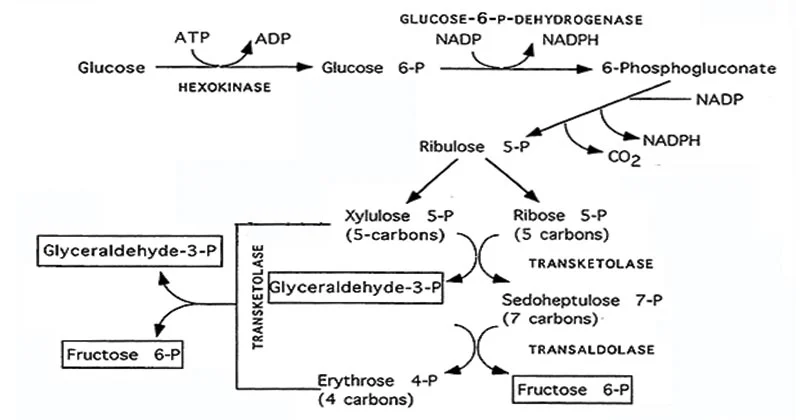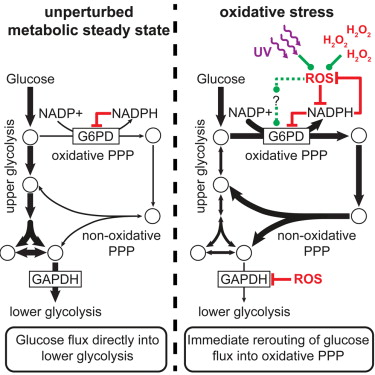
ABSTRACT:
In this article, we will discuss about the fascinating mechanism of pentose phosphate pathway. The pentose phosphate pathway (PPP), also known as the phosphogluconate pathway or hexose monophosphate shunt. It is a crucial metabolic pathway that operates alongside glycolysis. It plays a vital role in generating reducing power in the form of NADPH and producing ribose-5-phosphate, a precursor for nucleotide synthesis. We will also describe the different regulations of mechanism. We will also provide references to understand the concept deeply.
INTRODUCTION OF MECHANISM OF PENTOSE PHOSPHATE PATHWAY:
The Pentose Phosphate Pathway (PPP), also known as the hexose monophosphate shunt, is a crucial metabolic pathway that plays a vital role in cellular health. It is an alternative pathway to glycolysis, and its primary function is to generate reducing power in the form of NADPH (nicotinamide adenine dinucleotide phosphate) and ribose-5-phosphate, a precursor for nucleotide synthesis. The PPP involved in various physiological processes, including antioxidant defense, biosynthesis of fatty acids and nucleotides, and maintenance of redox balance. This article will explore the significance of the PPP in cellular metabolism and its implications in human health.
MECHANISM OF PENTOSE PHOSPHATE PATHWAY:
The PPP consists of two distinct phases: the oxidative phase and the non-oxidative phase. The oxidative phase is responsible for generating NADPH, while the non-oxidative phase produces ribose-5-phosphate.
1. OXIDATIVE PHASE:
The oxidative phase of the PPP begins with the conversion of glucose-6-phosphate (G6P) to 6-phosphoglucono-δ-lactone (6PGL) by the enzyme glucose-6-phosphate dehydrogenase (G6PDH). This reaction is the rate-limiting step of the pathway and is accompanied by the reduction of NADP+ to NADPH. 6PGL then hydrolyzed by 6-phosphogluconolactonase (6PGL) to form 6-phosphogluconate (6PG). Subsequently, 6PG decarboxylated by 6-phosphogluconate dehydrogenase (6PGDH), generating ribulose-5-phosphate (Ru5P) and another molecule of NADPH.
2. NON-OXIDATIVE PHASE:
The non-oxidative phase of the PPP involves a series of reversible reactions that interconvert various sugar phosphates. Ru5P can convert to ribose-5-phosphate (R5P) by the enzyme ribose-5-phosphate isomerase (RPI). Alternatively, R5P can converted back to Ru5P through a series of reactions involving transketolase (TKT) and transaldolase (TAL). These reactions allow for the generation of various sugar phosphates, which can utilized for nucleotide synthesis or fed back into glycolysis.

REGULATION OF MECHANISM OF PENTOSE PHOSPHATE PATHWAY:
The PPP tightly regulated to maintain cellular redox balance and meet the demands for nucleotide synthesis. Several factors influence the regulation of the PPP, including substrate availability, enzyme activity, and the cellular redox state.
1. SUBSTRATE AVAILABILITY:
The availability of glucose-6-phosphate (G6P) is a crucial determinant of PPP activity. G6P derived from glucose through glycolysis or from glycogen breakdown. High levels of G6P promote PPP flux, while low levels favor glycolysis.
2. ENZYMATIC REGULATION OF MECHANISM OF PENTOSE PHOSPHATE PATHWAY:
The rate-limiting enzyme, glucose-6-phosphate dehydrogenase (G6PDH), is subject to regulation by various factors. G6PDH activity stimulated by NADP+ and insulin, while it inhibited by NADPH and its downstream product, ribose-5-phosphate.
3. CELLULAR REDOX STATE OF MECHANISM OF PENTOSE PHOSPHATE PATHWAY:
The PPP is highly responsive to the cellular redox state. High levels of NADPH inhibit G6PDH activity, while low levels stimulate it. This feedback regulation ensures that the PPP produces NADPH only when it required for reductive biosynthesis or antioxidant defense.

ROLE OF PENTOSE PHOSPHATE PATHWAY IN CELLULAR HEALTH:
The PPP plays a critical role in maintaining cellular redox balance. NADPH generated during the oxidative phase of the PPP is essential for the regeneration of glutathione, a potent antioxidant that protects cells from oxidative damage. Glutathione acts as a scavenger of reactive oxygen species (ROS) and helps maintain the intracellular redox state. Imbalances in the PPP can lead to increased oxidative stress and contribute to the development of various diseases, including cancer, neurodegenerative disorders, and cardiovascular diseases.
IMPLICATIONS IN HUMAN HEALTH:
Dysregulation of the PPP has implicated in various diseases. Mutations in the gene encoding glucose-6-phosphate dehydrogenase (G6PD), the rate-limiting enzyme of the PPP, can lead to G6PD deficiency, a common enzymatic disorder. G6PD deficiency associated with increased susceptibility to oxidative stress and can result in hemolytic anemia, especially in response to certain drugs or infections. Moreover, alterations in the PPP have observed in cancer cells. Cancer cells often exhibit increased glucose metabolism and rely heavily on the PPP to generate NADPH and ribose-5-phosphate for their rapid proliferation. Targeting the PPP has emerged as a potential therapeutic strategy for cancer treatment, as inhibiting this pathway can disrupt cancer cell metabolism and induce cell death.
CONCLUSION:
The Pentose Phosphate Pathway is a crucial metabolic pathway that plays a vital role in cellular health. It provides reducing power in the form of NADPH and serves as a source of ribose-5-phosphate for nucleotide synthesis. The PPP involved in various physiological processes, including antioxidant defense, biosynthesis of fatty acids and nucleotides, and maintenance of redox balance. Dysregulation of the PPP has implicated in various diseases, highlighting its significance in human health. Further research into the PPP and its regulation may provide valuable insights into the development of novel therapeutic strategies for various diseases.
REFERENCES:
Stincone, A., Prigione, A., Cramer, T., Wamelink, M. M., Campbell, K., Cheung, E., … & Rabinowitz, J. D. (2015). The return of metabolism: biochemistry and physiology of the pentose phosphate pathway. Biological reviews, 90(3), 927-963. https://pubmed.ncbi.nlm.nih.gov/25243985/
Zhang, Y., & Rao, R. (2018). Beyond the pentose phosphate pathway: a metabolic perspective on antifungal resistance. PLoS pathogens, 14(12), e1007357. https://journals.plos.org/plospathogens/article?id=10.1371/journal.ppat.1009326
Zhang, D., Li, J., Wang, F., Hu, J., Wang, S., Sun, Y., … & Li, Y. (2020). The pentose phosphate pathway in cancer: a metabolic redox sensor and an anti-tumor therapeutic target. Frontiers in oncology, 10, 205. https://www.ncbi.nlm.nih.gov/pmc/articles/PMC6444344/
Ralser, M., Wamelink, M. M., Kowald, A., Gerisch, B., Heeren, G., Struys, E. A., … & Lehrach, H. (2007). Dynamic rerouting of the carbohydrate flux is key to counteracting oxidative stress. Journal of biology, 6(4), 10. https://jbiol.biomedcentral.com/articles/10.1186/jbiol61


